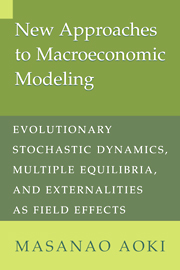 New Approaches to Macroeconomic Modeling
New Approaches to Macroeconomic Modeling Book contents
- Frontmatter
- Contents
- Preface
- Part I Introduction
- Part II Modeling Interactions
- Part III Hierarchical Dynamics and Critical Phenomena
- 7 Sluggish Dynamics and Hierarchical State Spaces
- 8 Self-organizing and Other Critical Phenomena in Economic Models
- Elaborations and Future Directions of Research
- Appendix
- References
- Index
8 - Self-organizing and Other Critical Phenomena in Economic Models
Published online by Cambridge University Press: 05 May 2010
- Frontmatter
- Contents
- Preface
- Part I Introduction
- Part II Modeling Interactions
- Part III Hierarchical Dynamics and Critical Phenomena
- 7 Sluggish Dynamics and Hierarchical State Spaces
- 8 Self-organizing and Other Critical Phenomena in Economic Models
- Elaborations and Future Directions of Research
- Appendix
- References
- Index
Summary
We sometimes observe major or drastic qualitative changes in the behavioral pattern or response of economic systems. Some of these changes are apparently triggered by minor changes in economic environments or policy parameters. For convenience, we call these responses “critical phenomena,” which are economic phenomena that are overly sensitive to changes in environments or policies.
We mention two types of such phenomena. One type involves sudden changes in structure: An equilibrium may suddenly bifurcate when some model parameter crosses a critical value. Organized markets may suddenly emerge when none existed before, or may suddenly disappear. There are many examples of these types of critical phenomena.
The other type of events is also well known. We call it a piling-up phenomena. These events are often marked by crazes or fads: A significant fraction of agents suddenly have the same opinion or make a same choice, or otherwise occupy the same configuration or state, while they were more or less evenly distributed among several states in the absence of whatever triggered this sudden shift. (Recall that a state could refer to economic or expectational conditions or both.) For lack of a better term we call them piling-up of agents, or dense occupancy of a state by agents.
Sudden structural changes
There are two senses in which sudden structural changes are relevant in economic modeling. One sense is familiar. Loosely put, discontinuous or major changes are produced in some properties or characteristics of systems or models as some parameter values are changed slightly near a so-called critical value. Examples are numerous both inside and outside economics.
- Type
- Chapter
- Information
- New Approaches to Macroeconomic ModelingEvolutionary Stochastic Dynamics, Multiple Equilibria, and Externalities as Field Effects, pp. 213 - 225Publisher: Cambridge University PressPrint publication year: 1996


